Dissertation | Thesis by Leif Schenstead-Harris
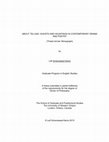
University of Western Ontario, Electronic Thesis and Dissertation Repository , Aug 28, 2015
[To read this dissertation, please click on the link to http://ir.lib.uwo.ca/etd/3091/ above]
... more [To read this dissertation, please click on the link to http://ir.lib.uwo.ca/etd/3091/ above]
It is difficult to think of something as formally resistant to definition as a ghost. What is more ambiguous than something described as “haunting”? Few currents in literature have been as prominent – and as comparatively unremarked – as the current critical and literary dependence on the language of spectrality. While ghost stories in prose have gained substantial attention, in drama and poetry ghosts and hauntings have found less critical purchase.
In response, this dissertation takes up a selection of drama and poetry from Ireland, South Africa, and the Caribbean to illustrate the theoretical and critical potential of ghosts and ghost stories in twentieth-century Anglophone world literatures. Selections are picked for their illustrative potential and thematic richness. The constellation of texts articulate a dazzling range of ghosts and ghost stories used creatively to reflect deep investigations and critical awarenesses of metaphors of haunting in epistemological and literary discourses.
The first half of “About Telling” examines ghost stories as performances on the theatrical stage to ask questions of relation and narrative (in Conor McPherson’s The Weir), nation and song (in Marina Carr’s By the Bog of Cats…), globalizing technologies and economic change (in Athol Fugard, John Kani, and Winston Ntshona’s Sizwe Banzi is Dead), theatre as technology (in Samuel Beckett’s Shades trilogy) and, finally, mourning and the lament (in J.M. Synge’s Riders to the Sea and Derek Walcott’s The Sea at Dauphin). Each chapter takes up a re-envisioned relationship between drama, narrative, and ghosts.
The second half of “About Telling” turns to poetry and questions of lyric theory: tradition and spectropoetics (in Eavan Boland), gothic prosopopoeia (in Breyten Breytenbach), lyric experimentation (in Samuel Beckett), and ekphrastic addresses (in the discrete responses of David Dabydeen and NourbeSe Philip) to the history of the Zong. Once decreated, poetry’s intense pressure on meaning-making in language reveals not stories but ghosts themselves.
Refusing transcendental definitions of ghosts and hauntings, this dissertation suggests that the manifold significance of terms such as “ghosts” and “haunting” can organize formal readings of poetry and drama in a recognizable heuristic. In short, language affords the resources for ghosts to enter and survive in our world.
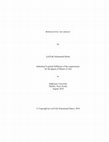
Approaching the library as a polyvocal, self-contradictory and even paradoxical dream, this thesi... more Approaching the library as a polyvocal, self-contradictory and even paradoxical dream, this thesis examines five select texts to see how this dream emerges across vastly different representations in fiction. Discussed texts include Jorge Luis Borges' "The Library of Babel" and "The Book of Sand", Michael Ondaatje's The English Patient, Ian McEwan's Atonement and Thomas Wharton's Salamander. Special attention is given to the archetypical opposition between daytime's clarity and night's disorder, as well as to Alberto Manguel's two hypothesized library-foundational myths, the Tower of Babel and the Library of Alexandria. Although it attempts to remain conscious of social realities surrounding and producing historical libraries, this thesis is primarily concerned with the textual irruption of libraries in fictional narratives, and while its argument articulates the problematic dimension of libraries, it also attempts to show how libraries are healthy, necessary, and even inevitable human creations.
Papers by Leif Schenstead-Harris
More Noises from Outside the Humanities
ESC: English Studies in Canada, 2018
In lieu of an abstract, here is a brief excerpt of the content:
THE THING ABOUT THE SHOCK OF ICE... more In lieu of an abstract, here is a brief excerpt of the content:
THE THING ABOUT THE SHOCK OF ICE WATER is that it can be enlivening, even refreshing. But total ice water immersion? It numbs you. The ice-cold shock of collective pandemic-era policy—stay home, shut down, switch to online platforms, be distant from the work of essential workers (unless you happen to be classified as such)—has given way to the kind of muted discombobulation of reopenings, cautious "staycations," and other experiments. The shocks are social, cultural, and economic; they are racialized, gendered, and class-distributed. It is difficult to know exact statistics in Canada, but early in the time of writing this piece, journalists

Noises from Outside the Humanities: Outrage and Climate Change
ESC: English Studies in Canada, 2018
In lieu of an abstract, here is a brief excerpt of the content:
I. Climate
In the backdrop to t... more In lieu of an abstract, here is a brief excerpt of the content:
I. Climate
In the backdrop to the exhortations of Swedish climate activist Greta Thunberg is a tradition of contemporary writing that seems to have emerged in an incredibly compressed time and that may have been obscured by its timeliness: the literature of ecological catastrophe. Today, this literature seems to be dominated by natural scientists and popular writers occasionally rooted in the social sciences. Unlike its cousin, the dystopia or science fiction of climate catastrophe, this new writing directly and specifically recognizes changes influencing our world, and it is often read by audiences with a gravity distinct from other works. Writers in this tradition are familiar; here is an arbitrary list: Naomi Klein, Bill McKibbon, Rebecca Solnit, George Monbiot, Nathaniel Rich, Daniel Wilson-Wells. Their lineage...
New West Indian Guide / Nieuwe West-Indische Gids
This is an open access article distributed under the terms of the cc by 4.0 license.
Crossings: Journal of Migration & Culture, 2017
What is the relationship between migration and poetry? By examining poetry by Caribbean writers L... more What is the relationship between migration and poetry? By examining poetry by Caribbean writers Louise Bennett and Kamau Brathwaite, this article provides historical context and alternative ways of answering this question. Theoretically speaking, this article embarks on the conceptual path of Aimé Cesairé's use of négritude as a 'compass of suffering'. It does so by adopting Vijay Prashad and Shailja Patel's term migritude or an aesthetic attempt to live within the idea of the migrant subject. The article begins with a sketch that examines Warsan Shire's poem 'Home' in the context of the Syrian refugee crisis. It then looks into the archive of Bennett's and Brathwaite's poetry to see how poems written by migrant authors help to shape visions of migration and migrant subjects.
Mosaic: an interdisciplinary critical journal, 2018
Prose fictions such as Chris Abani’s Becoming Abigail and Dave Eggers’s What Is the What mobilize... more Prose fictions such as Chris Abani’s Becoming Abigail and Dave Eggers’s What Is the What mobilize their readers’ readiness to identify with a given protagonist through differently haunted styles of fictional presentation. This essay explores how Eggers and Abani either embrace or refuse the ambiguous lies and troubled authenticity of ghostwriting.

Caribbean Irish Connections: Interdisciplinary Perspectives (Ch. 12), 2015
Written in the late reaches of a dominant colonial tongue, the plays of J.M. Synge and Derek Walc... more Written in the late reaches of a dominant colonial tongue, the plays of J.M. Synge and Derek Walcott have created spaces of linguistic autonomy in English for minoritarian expression. Famously, Walcott has commented that he feels close to Irish writers, especially Synge, because “they were also colonials with the same kind of problems that existed in the Caribbean” (1979, 288). Following this connection and the accumulating scholarly work connecting these cultural traditions, this paper examines how Synge’s early play Riders to the Sea (1904) and Walcott’s The Sea at Dauphin (1954) adopt mourning and ghosts to intensify and change language. I argue that the plays’ ghosts emanate from the unreadable archive of the ocean as figures of unforgotten absence. Their hauntings provoke a mournful linguistic renewal but, crucially, provide characters no consolatory recompense. In other words, language emerges new but empty-handed from mourning beside the haunted sea; it expresses nothing but its own survival in the face of a memento mori and, in so doing, changes immeasurably.
The Unrecyclable, Oct 2013
Conference Presentations by Leif Schenstead-Harris
This conversational presentation was delivered at the third annual Sustainability Across Discipli... more This conversational presentation was delivered at the third annual Sustainability Across Disciplines conference, hosted by the Loyola Sustainability Research Centre at Concordia University. From the perspective of public policy development, it briefly explores the concept of contemporary Arctic urban development and focuses on the specific policy issues of waste and tourism.
This conversational presentation was delivered at the second annual Sustainability Across Discipl... more This conversational presentation was delivered at the second annual Sustainability Across Disciplines conference, hosted by the Loyola Sustainability Research Centre at Concordia University. From the perspective of public policy development, it briefly explores the context of international sustainable development in the Arctic through the prism of the Arctic Council.
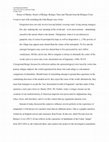
Stories that concern refugees make considerable claims regarding the need for representational fo... more Stories that concern refugees make considerable claims regarding the need for representational forms contained in literary discourse to carry societal weight; in other words, stories about refugees address themselves to the ongoing political and social crisis of migration. This paper considers two recent examples of “refugee literature”, the multiply-authored Refugee Tales (2016), a collection that adopts the Chaucerian pilgrimage format, and Kate Evans’ Threads from the Refugee Crisis (2017), a graphic novel in the vein of Joe Sacco’s Palestine (1996) that narrates its author’s experiences in the Calais Jungle. While both texts hybridize their literary form, they do so for with different political and aesthetic effects. Ultimately, this paper seeks to ascertain the relevance of these literary narratives to their seemingly direct objects of reference: communities of refugees, asylum seekers, and the reading public.
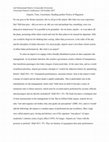
Have you been to an airport? Has time passed—have you moved on, waited, been delayed or turned aw... more Have you been to an airport? Has time passed—have you moved on, waited, been delayed or turned away? In 1995, Marc Augé characterized international airport terminals as super-modernity’s “non-places” or stateless zones of grey affect (Non-Places). Yet these sites are not “non-places”—an illusion of impatient movement—but carefully designed zones of sovereign statelessness that yield theoretical material in their everyday operation. Thus, when 600 Chinese migrants arrived in staggered waves on smuggler boats across the BC Coast in 1999, Canadian Immigration Control officials declared the “long tunnel thesis” to process these migrants without interference from lawyers and without declaring their arrival in Canada. Just as a long tunnel separates a plane from the customs desk, a “long tunnel thesis” separated these migrants from their human rights. Similarly, in an article titled “Trump’s Airport Kingdom,” Sam Kriss (2017) reads the initial American flight ban on Muslim travellers (or, officially, travellers from seven countries, all majority Muslim) as an exercise in permissiveness; it allows border police to go beyond the ban’s regulations, as stated in the executive order, and push forward in the spirit of the ban’s Islamophobia. This too is a tradition of American immigration police who, in ceaselessly and aggressively inventive uses of their fundamental writs of official creation, craft new poetics of behaviour, tools, and legal discourses to justify their behaviour (Kang, INS on the Line 2017). Kriss observes that airports present a “excruciatingly banal and sharply horrifying experience” for any traveller (2017). In the study of migration, this poetics is not singular but startling, an exception in an age of political exceptionalism (Agamben, State of Exception 2005).
The metaphors of airport modernity—characterized by an apparently missing state and designated statelessness that calls itself into being in a moment of crisis while holding invisible powers of demarcation—now infiltrate other purportedly timeless places of waiting and formal deportation. This paper follows those metaphors to read the tools that implement migration policies and politics as a form of poetics, a kind of making and unmaking of bodies (to remember a phrase used by Elaine Scarry, The Body in Pain 1985). To read these migrational poetics, I examine contemporary spaces of detention and airport border crossing, considering the cases of modern regulations in United States airports and deportation case studies in North America. The future promised by the exceptional space is twofold: to pass through or to be returned. Whose bodies are at risk? What kind of future is promised by the long tunnel and the shadowy world of deportation that creeps closer and closer to hegemonic society? Airports speak to one version of this ever uncertain future through a creative poetics of migration.
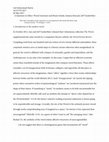
Congress 2017
In October 2012, Ann and Jeff VanderMeer released their voluminous collection The Weird, suppleme... more In October 2012, Ann and Jeff VanderMeer released their voluminous collection The Weird, supplemented the same month by a companion literary website, the Weird Fiction Review. Compiling work from one hundred and one writers of over twenty different nationalities, these conjoined ventures serve as initial maps to a literary terrain otherwise often marginalized. In general, the weird is affiliated with critiques of rationality, gender and imperialism, and the Anthropocene, to use only a few examples. In this essay, I argue that an affective economy unites these manifold strands of the imagination that compose weird literature. These affects resemble a set of transgressions built of dreams, collapses, and regrowths; all take place as affective structures of the imagination, where “affect” signifies a force that creates relationships between bodies and the world (Berlant 2011). Such “transgressions” are merely the tipping points where normative orders of epistemological “realisms” are reordered and poured into the shape of their future. If something is “weird,” its aesthetic seems to be both uncontestable but yet unprecedented. Miéville calls such an aesthetic the attempt to “shove a fate-shaped key at the Weird keyhole” (1114): the future’s selective reading of present unknowns is always going to be unpredictable and strange. Crucially, the site of the Weird is the untimely present viewed through newly comprehending eyes; if imagined as a space, “its interior is less repressed than unrecognized” (Miéville 1115). As a genre of what I want to call “the emerging event,” after Berlant (5), the aesthetic of the weird relates affective structures of unrecognizability. [...]
This paper reads select passages from Kamau Brathwaite and Louise Bennett by examining arrival an... more This paper reads select passages from Kamau Brathwaite and Louise Bennett by examining arrival and migration as intense moments in the archives of Caribbean poetry. For these poets, the Caribbean is both a home for immigrants but also a source of emigration. At the same time, thinking about the failures of language, Caribbean writers suggest that poetry is an opportunity for an archive to sound anew with revitalized performances. As Brathwaite writes, language becomes “a howl or a shout or a machine gun or the wind or a wave.” This paper suggests that poetry turns the failed speech and impossible sounds of dispersed peoples to the revitalized repository of linguistic archives.
W]e are not asked to condemn this being with the mad heart, this being with whom there is somethi... more W]e are not asked to condemn this being with the mad heart, this being with whom there is something constitutionally wrong. On the contrary, we are invited to understand and sympathize. But there is a limit to sympathy. For though he lives among us, he is not one of us. He is exactly what he calls himself: a thing, that is, a monster.
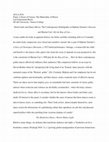
This paper considers the affective creation in two dances of death in the contemporary gothic.
... more This paper considers the affective creation in two dances of death in the contemporary gothic.
In Japanese butoh, a performance Steven Bruhm reminds us means the “dance of utter darkness,” performers act without affect in horrific performances: impossibly grotesque gestures are performed with maddening grace and slowness. As choreographer Tatsumi Hijikata explains of performers such as Kazuo Ohno, in butoh “dead gestures inside my body die one more time and make the dead themselves dead again.” This dance sheds a dancer’s subjectivity and resembles the psychological condition of anosagnosia, where the brain’s limbic system misperceives the body that carries it. Anosagnosia is characterized by a lack of kinaesthetic torsion and by conflicting affective states: shock, hilarity, horror.
A similar dance happens on stage in Marina Carr’s By the Bog of Cats… (1998). Carr’s female protagonist Hester Swane concludes the play by killing her small daughter and herself while wrestling with another character called the Ghost Fancier. The murder-suicide comes with an interpretative twist: characters in the play see Hester’s actions but not the Ghost Fancier. To the audience, Hester’s acts are predicated on a fierce dance with fateful death: terrible, but oddly invigorating as the conclusion of a play that yields high emotional rewards. To characters, her grim acts horrifically dislocate agency by refusing life tout court.
While drawn from different classical traditions, Hjikata’s butoh and Carr’s modern dans macabre present visions of subject-formation that contrast of horror and terror. Their comparison articulates a possible global resonance: not in the sense of worldly, but in the medical sense. What might a material body do on the dramatic stage?











Uploads
Dissertation | Thesis by Leif Schenstead-Harris
It is difficult to think of something as formally resistant to definition as a ghost. What is more ambiguous than something described as “haunting”? Few currents in literature have been as prominent – and as comparatively unremarked – as the current critical and literary dependence on the language of spectrality. While ghost stories in prose have gained substantial attention, in drama and poetry ghosts and hauntings have found less critical purchase.
In response, this dissertation takes up a selection of drama and poetry from Ireland, South Africa, and the Caribbean to illustrate the theoretical and critical potential of ghosts and ghost stories in twentieth-century Anglophone world literatures. Selections are picked for their illustrative potential and thematic richness. The constellation of texts articulate a dazzling range of ghosts and ghost stories used creatively to reflect deep investigations and critical awarenesses of metaphors of haunting in epistemological and literary discourses.
The first half of “About Telling” examines ghost stories as performances on the theatrical stage to ask questions of relation and narrative (in Conor McPherson’s The Weir), nation and song (in Marina Carr’s By the Bog of Cats…), globalizing technologies and economic change (in Athol Fugard, John Kani, and Winston Ntshona’s Sizwe Banzi is Dead), theatre as technology (in Samuel Beckett’s Shades trilogy) and, finally, mourning and the lament (in J.M. Synge’s Riders to the Sea and Derek Walcott’s The Sea at Dauphin). Each chapter takes up a re-envisioned relationship between drama, narrative, and ghosts.
The second half of “About Telling” turns to poetry and questions of lyric theory: tradition and spectropoetics (in Eavan Boland), gothic prosopopoeia (in Breyten Breytenbach), lyric experimentation (in Samuel Beckett), and ekphrastic addresses (in the discrete responses of David Dabydeen and NourbeSe Philip) to the history of the Zong. Once decreated, poetry’s intense pressure on meaning-making in language reveals not stories but ghosts themselves.
Refusing transcendental definitions of ghosts and hauntings, this dissertation suggests that the manifold significance of terms such as “ghosts” and “haunting” can organize formal readings of poetry and drama in a recognizable heuristic. In short, language affords the resources for ghosts to enter and survive in our world.
Papers by Leif Schenstead-Harris
THE THING ABOUT THE SHOCK OF ICE WATER is that it can be enlivening, even refreshing. But total ice water immersion? It numbs you. The ice-cold shock of collective pandemic-era policy—stay home, shut down, switch to online platforms, be distant from the work of essential workers (unless you happen to be classified as such)—has given way to the kind of muted discombobulation of reopenings, cautious "staycations," and other experiments. The shocks are social, cultural, and economic; they are racialized, gendered, and class-distributed. It is difficult to know exact statistics in Canada, but early in the time of writing this piece, journalists
I. Climate
In the backdrop to the exhortations of Swedish climate activist Greta Thunberg is a tradition of contemporary writing that seems to have emerged in an incredibly compressed time and that may have been obscured by its timeliness: the literature of ecological catastrophe. Today, this literature seems to be dominated by natural scientists and popular writers occasionally rooted in the social sciences. Unlike its cousin, the dystopia or science fiction of climate catastrophe, this new writing directly and specifically recognizes changes influencing our world, and it is often read by audiences with a gravity distinct from other works. Writers in this tradition are familiar; here is an arbitrary list: Naomi Klein, Bill McKibbon, Rebecca Solnit, George Monbiot, Nathaniel Rich, Daniel Wilson-Wells. Their lineage...
Conference Presentations by Leif Schenstead-Harris
The metaphors of airport modernity—characterized by an apparently missing state and designated statelessness that calls itself into being in a moment of crisis while holding invisible powers of demarcation—now infiltrate other purportedly timeless places of waiting and formal deportation. This paper follows those metaphors to read the tools that implement migration policies and politics as a form of poetics, a kind of making and unmaking of bodies (to remember a phrase used by Elaine Scarry, The Body in Pain 1985). To read these migrational poetics, I examine contemporary spaces of detention and airport border crossing, considering the cases of modern regulations in United States airports and deportation case studies in North America. The future promised by the exceptional space is twofold: to pass through or to be returned. Whose bodies are at risk? What kind of future is promised by the long tunnel and the shadowy world of deportation that creeps closer and closer to hegemonic society? Airports speak to one version of this ever uncertain future through a creative poetics of migration.
In Japanese butoh, a performance Steven Bruhm reminds us means the “dance of utter darkness,” performers act without affect in horrific performances: impossibly grotesque gestures are performed with maddening grace and slowness. As choreographer Tatsumi Hijikata explains of performers such as Kazuo Ohno, in butoh “dead gestures inside my body die one more time and make the dead themselves dead again.” This dance sheds a dancer’s subjectivity and resembles the psychological condition of anosagnosia, where the brain’s limbic system misperceives the body that carries it. Anosagnosia is characterized by a lack of kinaesthetic torsion and by conflicting affective states: shock, hilarity, horror.
A similar dance happens on stage in Marina Carr’s By the Bog of Cats… (1998). Carr’s female protagonist Hester Swane concludes the play by killing her small daughter and herself while wrestling with another character called the Ghost Fancier. The murder-suicide comes with an interpretative twist: characters in the play see Hester’s actions but not the Ghost Fancier. To the audience, Hester’s acts are predicated on a fierce dance with fateful death: terrible, but oddly invigorating as the conclusion of a play that yields high emotional rewards. To characters, her grim acts horrifically dislocate agency by refusing life tout court.
While drawn from different classical traditions, Hjikata’s butoh and Carr’s modern dans macabre present visions of subject-formation that contrast of horror and terror. Their comparison articulates a possible global resonance: not in the sense of worldly, but in the medical sense. What might a material body do on the dramatic stage?
It is difficult to think of something as formally resistant to definition as a ghost. What is more ambiguous than something described as “haunting”? Few currents in literature have been as prominent – and as comparatively unremarked – as the current critical and literary dependence on the language of spectrality. While ghost stories in prose have gained substantial attention, in drama and poetry ghosts and hauntings have found less critical purchase.
In response, this dissertation takes up a selection of drama and poetry from Ireland, South Africa, and the Caribbean to illustrate the theoretical and critical potential of ghosts and ghost stories in twentieth-century Anglophone world literatures. Selections are picked for their illustrative potential and thematic richness. The constellation of texts articulate a dazzling range of ghosts and ghost stories used creatively to reflect deep investigations and critical awarenesses of metaphors of haunting in epistemological and literary discourses.
The first half of “About Telling” examines ghost stories as performances on the theatrical stage to ask questions of relation and narrative (in Conor McPherson’s The Weir), nation and song (in Marina Carr’s By the Bog of Cats…), globalizing technologies and economic change (in Athol Fugard, John Kani, and Winston Ntshona’s Sizwe Banzi is Dead), theatre as technology (in Samuel Beckett’s Shades trilogy) and, finally, mourning and the lament (in J.M. Synge’s Riders to the Sea and Derek Walcott’s The Sea at Dauphin). Each chapter takes up a re-envisioned relationship between drama, narrative, and ghosts.
The second half of “About Telling” turns to poetry and questions of lyric theory: tradition and spectropoetics (in Eavan Boland), gothic prosopopoeia (in Breyten Breytenbach), lyric experimentation (in Samuel Beckett), and ekphrastic addresses (in the discrete responses of David Dabydeen and NourbeSe Philip) to the history of the Zong. Once decreated, poetry’s intense pressure on meaning-making in language reveals not stories but ghosts themselves.
Refusing transcendental definitions of ghosts and hauntings, this dissertation suggests that the manifold significance of terms such as “ghosts” and “haunting” can organize formal readings of poetry and drama in a recognizable heuristic. In short, language affords the resources for ghosts to enter and survive in our world.
THE THING ABOUT THE SHOCK OF ICE WATER is that it can be enlivening, even refreshing. But total ice water immersion? It numbs you. The ice-cold shock of collective pandemic-era policy—stay home, shut down, switch to online platforms, be distant from the work of essential workers (unless you happen to be classified as such)—has given way to the kind of muted discombobulation of reopenings, cautious "staycations," and other experiments. The shocks are social, cultural, and economic; they are racialized, gendered, and class-distributed. It is difficult to know exact statistics in Canada, but early in the time of writing this piece, journalists
I. Climate
In the backdrop to the exhortations of Swedish climate activist Greta Thunberg is a tradition of contemporary writing that seems to have emerged in an incredibly compressed time and that may have been obscured by its timeliness: the literature of ecological catastrophe. Today, this literature seems to be dominated by natural scientists and popular writers occasionally rooted in the social sciences. Unlike its cousin, the dystopia or science fiction of climate catastrophe, this new writing directly and specifically recognizes changes influencing our world, and it is often read by audiences with a gravity distinct from other works. Writers in this tradition are familiar; here is an arbitrary list: Naomi Klein, Bill McKibbon, Rebecca Solnit, George Monbiot, Nathaniel Rich, Daniel Wilson-Wells. Their lineage...
The metaphors of airport modernity—characterized by an apparently missing state and designated statelessness that calls itself into being in a moment of crisis while holding invisible powers of demarcation—now infiltrate other purportedly timeless places of waiting and formal deportation. This paper follows those metaphors to read the tools that implement migration policies and politics as a form of poetics, a kind of making and unmaking of bodies (to remember a phrase used by Elaine Scarry, The Body in Pain 1985). To read these migrational poetics, I examine contemporary spaces of detention and airport border crossing, considering the cases of modern regulations in United States airports and deportation case studies in North America. The future promised by the exceptional space is twofold: to pass through or to be returned. Whose bodies are at risk? What kind of future is promised by the long tunnel and the shadowy world of deportation that creeps closer and closer to hegemonic society? Airports speak to one version of this ever uncertain future through a creative poetics of migration.
In Japanese butoh, a performance Steven Bruhm reminds us means the “dance of utter darkness,” performers act without affect in horrific performances: impossibly grotesque gestures are performed with maddening grace and slowness. As choreographer Tatsumi Hijikata explains of performers such as Kazuo Ohno, in butoh “dead gestures inside my body die one more time and make the dead themselves dead again.” This dance sheds a dancer’s subjectivity and resembles the psychological condition of anosagnosia, where the brain’s limbic system misperceives the body that carries it. Anosagnosia is characterized by a lack of kinaesthetic torsion and by conflicting affective states: shock, hilarity, horror.
A similar dance happens on stage in Marina Carr’s By the Bog of Cats… (1998). Carr’s female protagonist Hester Swane concludes the play by killing her small daughter and herself while wrestling with another character called the Ghost Fancier. The murder-suicide comes with an interpretative twist: characters in the play see Hester’s actions but not the Ghost Fancier. To the audience, Hester’s acts are predicated on a fierce dance with fateful death: terrible, but oddly invigorating as the conclusion of a play that yields high emotional rewards. To characters, her grim acts horrifically dislocate agency by refusing life tout court.
While drawn from different classical traditions, Hjikata’s butoh and Carr’s modern dans macabre present visions of subject-formation that contrast of horror and terror. Their comparison articulates a possible global resonance: not in the sense of worldly, but in the medical sense. What might a material body do on the dramatic stage?
Guyanese writer David Dabydeen’s Turner (1995) exemplifies this second type of haunting logic. The poem (or verse novel) is an extended narrative emerging from the drowning figure in J.M.W. Turner’s famous painting Slave Ship. Dabydeen’s intention to provoke questions of justice is explicit, but so too are his acknowledgements about the difficulties of such a poetic enterprise. As he writes, when the African lost to the sea awakens into his poem, “it [the African voice] can only partially recall the sources of its life, so it invents a body, a biography, and peoples an imagined landscape” (7). Here, when the exchange between invention and recollection becomes one between a living desire and a paralytic history, the poem becomes a haunted reflection on aesthetics and identity: consciousness, the poem’s creation through language, displays itself as “a garment of invention.”
With theoretical models from Agamben and Derrida, my paper examines the spectres of Dabydeen’s poem to articulate the connections between the poem’s inventive voice and its haunting exchange between desire and an impossible justice. In this analysis Turner is a transatlantic tour of passage where spectropoetics translate the images—the phantasms—of Slave Ship into a different medium, provoking a vibrant if impossible passage towards restitution, justice, and a new kind of vision where, as the poem’s voice admits, “Words are all I have left of my eyes” (IX). This paper thus works in the broad field of transatlantic literatures and employs the theory of hauntology to describe a form of contemporary poetics.
"Weird fiction is increasingly international even as it returns to traditional themes and concerns. It was not so long ago that Finnish fiction from authors such as Leena Krohn, Johanna Sinisalo, and Jyrki Vainonen became prominent in English-language discussions of the weird. WorldCon 75 is being held this August in Helsinki. There exists a palpable sense of excitement about the Nordic twist on weird writing. As Sinisalo wrote here at the WFR in 2012, where others might see and write about the world in straight lines, the Finnish weird is premised on “diagonal” relationships. In the hands of writers such as Sinisalo, fiction’s promise to readers is that, “when they open the book, anything could happen.”
At just about the same time as Sinisalo was advocating the diagonal properties of the Finnish weird, Karin Tidbeck’s startling and highly original collection of short stories Jagganath (Cheeky Frawg, 2012) emerged in English translation. The stories in Jagganath mark out Swedish territory in the Nordic weird tradition. Wintry and wise, they incorporate myths, mysteries, and familial histories. The recent English translation of Amatka follows on this early promise, although Swedish readers will know that Amatka was in fact released in its original language in 2012. Anglophone readers have had to wait some time for this book. [...]"
"Maybe I’m susceptible to some lurking horrors more than others, but Malcolm Devlin’s first short story collection, You Will Grow Into Them, gave me the creeps before I even opened the front cover. Is the gritty, textured skin so prominently foregrounded being pulled off—or is it put on, the way one would a glove? Why is the other skin so inhumanly shiny?
Suitably impressed by the dark tenor of this subversive aesthetic—the book’s “handshake” becomes a tender skin-graft, if you allow the metaphor—I was unprepared for the subtle humour that permeates these stories. In Devlin’s tales, a generous spirit busily hums under the threnody for a dying world."
Please see http://weirdfictionreview.com/2017/02/interview-conversation-nnedi-okorafor/
In lieu of an abstract, the introductory paragraph:
"Welcome to Japanese writer, poet, and critic Hagiwara Sakutarō’s cat-prowled grounds. Today we circle the Weird-collected tale of “Cat Town”. Hagiwara’s literary world is an assortment of marginal places, “a landscape as melancholy as a cat.” But this isn’t a kind of anthropomorphic feline world enmeshed within everyday human affairs such as Sōseki Natsume’s I Am a Cat (1905-6) or E.T.A. Hoffman’s The Life and Opinions of Tomcat Murr (1819-1821). Nor is it akin to the viral web media popularizing Japanese “cat islands” Tashirojima and Aoshima. Such spaces displace the human from socio-political vision; they certainly seem like fascinatingly inhuman communities. However, “cat islands” are no posthuman utopia, just as Hagiwara’s “Cat Town” is no fable for the future. In any case, technocultural utopias are too sleekly silvered for the weirdly inclined. Give us the blood’s recoil, the ineffable terror, the cat’s piercing eyes.[1] Unlike these places and tales, “Cat Town” conjures up a history of weird displacement in which the Anthropocene finds its conceptual feet by confronting an abyss of the real. As it does so, it offers a way for us to see the constructed symbolism of the contemporary world: a world of cats!"
In lieu of an abstract, the first paragraph:
What would you do if your eye was cut open? And what if your organ of sight, split in two, could still see – what if the first thing you saw was your eye’s distressing division? In surrealist art and literature, as in weird fiction more generally, the eye is a privileged site of conflict. The narrator of Leonora Carrington’s “White Rabbits” tells us that she can see anything in the gloom of Pest Street, the neighbourhood in which she lives. As she explains, “my eyes have always been excellent.” But the sights she sees are bewildering: tiny white teeth tearing apart rotting flesh; the human body, cloistered away and subject to leprosy; and then, in the story’s last, beautiful image, an apparition of a woman waving her hand over a gloomy balcony: “and as she waved it, her fingers fell off and dropped to the ground like shooting stars.”[2] This is an important and transformative image. To recognize it as such, we will need to examine a brief history of ideas of severance and sight, and especially of how a perceived fissure or disconnection with the world one sees can prompt a reinvigorated sense of agency. Severance and sight are our guides to “White Rabbits” and to Carrington’s surrealist artist and metaphysical thinking.
To see the paper, please click on the attached link underneath the title or navigate to here: http://weirdfictionreview.com/2015/07/101-weird-writers-36%E2%80%89-%E2%80%89saki/.
Please click the attached link if you wish to read the article: http://weirdfictionreview.com/2014/09/101-weird-writers-34-amos-tutuola/
Please note: this is a draft copy intended for observation only, and it has not been endorsed by the Department of English and Writing Studies at Western University; therefore, it in no way reflects that department's official or unofficial practices, and must be seen to exist only as a draft of a provisional document.
In lieu of an abstract, the first paragraph:
"Let us get properly introduced. Horthólary contains four stories that tell of strange events in the good professor’s life and span his childhood to old age. These stories partially follow from Reynier’s previous book, Five Degrees of Latitude (2011), also published by Tartarus Press, but read excellently to the newcomer in their own right. Along with Professor Horthólary, readers meet his lifelong friend Jean Gélis and the devilish priest Philippe Rapin, as well as the many other figures who populate Montagascony, a fictionalized rendition of mid-eighteenth century France. Each tale teasingly unravels its own weird thread and these, in turn, the book weaves into a unified iridescent fabric of narrative conception. The book is thus neither a collection nor a novel but something much more interesting: a hybrid narrative that engineers its successes through creative innovation and revisiting traditional tropes in equal measures."
A heretical study of laughter and jokes in Jorge Luis Borges' super serious short story, "Las ruinas circulares" (1949).